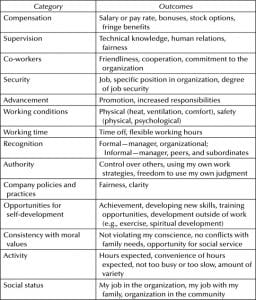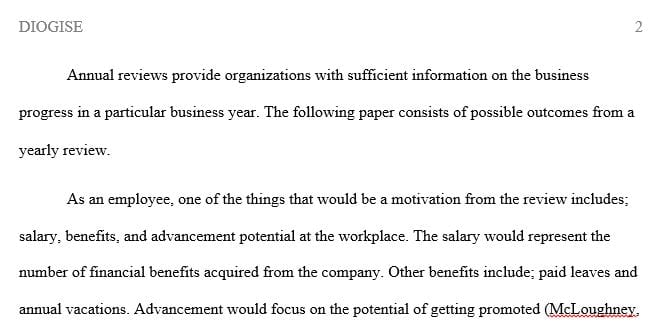Identify which three outcomes would be most motivating for you.
Review Table 8.1 on Page 97: “Possible Outcomes.”
Imagine you have just finished an annual review with your supervisor, with positive results. Identify which three outcomes would be most motivating for you.
Imagine you are a manager who just completed an average but generally positive annual review for one of your employees. Identify which three outcomes would be most motivating for the employee. Which would be the most beneficial for your organization?
Discuss why these two sets of three outcomes may or may not be the same, depending on whom they are designed to best serve.
Outcomes can be external or internal, formal or informal, positive or negative. Table 8.1 offers examples of outcomes to inspire you and your subordinates to think beyond the obvious ones. Go through this list, add to it, and ask how many are tied to performance (level of evaluation). Another approach is to ask what a person has to do to get each one.
CONSISTENCY
Consistency across people and over time together get at the fairness of the reward system.
Consistency across people means that two people whose performance (evaluation) is equal should get the same level of the outcome: the same raise, the same promotion opportunities, and the same recognition. Two people whose evaluations are different should get different outcomes.
Consistency over time means that evaluation levels that produced an outcome at one time should also produce it at a later time. This consistency (raises are based on the same factors again and again, for example) helps make the evaluation-to-outcome connection clear to people, and they have confidence that the connection will be the same in the future. Your job as a manager is to be clear on what outcomes should be based on evaluations. Then, make the connections clear, make sure these outcomes are based on valid evaluations, and that your subordinates perceive them as valid.
Do not expect everyone to agree that the reward system is fair. This is almost impossible because we all see the factors that should determine how much outcome we get in different ways. In addition, people don’t usually agree on the factors that should be considered in determining outcomes. Some think the only important factor should be performance. Others think factors such as need, seniority, and job knowledge should count. Even if all were to agree on what factors should be considered, they most likely won’t agree on how each person “scores ” on these factors. They will not likely agree on each other’s performance, their amount of job knowledge, etc. So it is rare for all to agree that the reward system is fair. What the manager needs to do is to make it as fair as possible, realizing that for all to agree it is fair is probably impossible.
Table 8.1.Possible Outcomes
The fairness of the reward system is a sensitive issue. Subordinates probably will not want to tell you, their manager, that they think you are not being fair. Nor will they be comfortable saying in a group meeting that they should get more outcomes than a co-worker. Other methods such as a survey could be helpful in getting at true perceptions.
EVALUATION-TO-OUTCOME CONNECTION DIAGNOSIS ROADMAP
A good way to start assessing the strength of the evaluation-to-outcome connection is by focusing on compensation. Ask your staff how compensation outcomes (pay level, pay raises, bonuses, financial incentives, stock options) are related to formal and informal evaluations. It may well be that few compensation outcomes are tied to evaluations, or that subordinates do not know which evaluations influence compensation outcomes.
After you map the important compensation outcomes, do the same with the outcome of recognition. Ask if your subordinates think levels of recognition are determined by how well they are performing (how positive the evaluations of their results are). Next ask what happens to the recognition they get if their evaluations go up or go down. You might get some surprising answers.
ACCURACY
As you assess, remember that like the other connections, evaluation-to-outcome connections are perceptions that may or may not be accurate. Significant misperceptions of these connections are common. A good example is promotions. In many organizations, it is not at all clear what factors determine promotions. People may have many different ideas about what is important. Some are convinced that what counts is how you dress, which part of the organization you work in, who your boss is, which customers you get assigned to, your technical prowess, or how personable you are at social functions. If these beliefs are inaccurate and the promotion is important, people will put large amounts of energy into actions that have nothing to do with getting the promotion and the actions done are irrelevant to the organization. A person who puts large amounts of effort into irrelevant actions at the expense of valued actions, and does not get the expected outcome, feels frustrated and confused.

Solution preview for the order on identify which three outcomes would be most motivating for you.
APA
314 words

